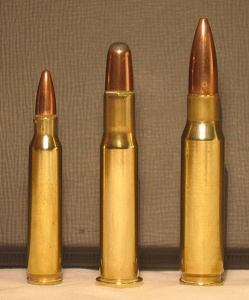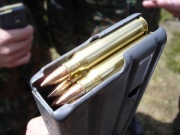.223 Remington
| .223 Remington | ||||||||||||||||||||||
|---|---|---|---|---|---|---|---|---|---|---|---|---|---|---|---|---|---|---|---|---|---|---|

| ||||||||||||||||||||||
| .223 Rem (left) next to .30-30 (center) and .308 (right) | ||||||||||||||||||||||
| Type | Rifle/varmint | |||||||||||||||||||||
| Country of Origin | United States | |||||||||||||||||||||
| Specifications | ||||||||||||||||||||||
| Parent Case | .222 Remington Magnum | |||||||||||||||||||||
| Case Type | Rimless, bottleneck | |||||||||||||||||||||
| Bullet Ø | .224 in (5.7 mm) | |||||||||||||||||||||
| Neck Ø | .253 in (6.4 mm) | |||||||||||||||||||||
| Shoulder Ø | .354 in (9.0 mm) | |||||||||||||||||||||
| Base Ø | .376 in (9.6 mm) | |||||||||||||||||||||
| Rim Ø | .378 in (9.6 mm) | |||||||||||||||||||||
| Rim Thickness | .045 in (1.1 mm) | |||||||||||||||||||||
| Case Length | 1.76 in (45 mm) | |||||||||||||||||||||
| Full Length | 2.26 in (57 mm) | |||||||||||||||||||||
| Rifling twist | 1/12" (typical) | |||||||||||||||||||||
| Primer | Small rifle | |||||||||||||||||||||
| Production & Service | ||||||||||||||||||||||
| Designer | Remington Arms | |||||||||||||||||||||
| Design Date | 1964 | |||||||||||||||||||||
| Production Dates | 1965-present | |||||||||||||||||||||
| Variants | .223 Ackley Improved, 5.56x45mm NATO | |||||||||||||||||||||
| Ballistic Performance Sampling | ||||||||||||||||||||||
| ||||||||||||||||||||||
The .223 Remington is a sporting cartridge with the same external dimensions as the 5.56x45mm NATO military cartridge. It is loaded with a 0.224-inch (5.7 mm) diameter, jacketed bullet, with weights ranging from 40 up to 90 grains (5.8 g), though the most common loading by far is 55 grains (3.6 g).
While the external case dimensions are very similar, the .223 Remington and 5.56x45mm differ in both maximum pressure and chamber shape. The maximum and mean pressures for some varieties the 5.56 mm (different cartridge designations have different standards) exceed the SAAMI maximums for the .223 Remington, and the methods for measuring pressures differ between NATO and SAAMI.[2] The 5.56 mm chamber specification has also changed over time since it's adoption, as the current military loading (NATO SS-109 or US M855) uses longer, heavier bullets than the original loading did. This has resulted in a lengthening of the throat in the 5.56 mm chamber. Thus, while .223 Remington ammunition can be safely fired in a 5.56 mm chambered gun, firing 5.56 mm ammunition in a .223 Remington chamber may produce pressures in excess of even the 5.56 mm specifications due to the shorter throat.[3]
Contents |
History
The .223 Remington was developed as an enlarged and higher velocity version of the .222 Remington, which was introduced in 1950 as a varmint cartridge. The .223 Remington was developed specifically for the Armalite AR-15, a version of which later became the U.S. military's M16 rifle.
Uses
The .223 Remington is one of the most common rifle cartridges in use in the United States, being widely used in two types of rifles: (1) varmint rifles, most of which are bolt action and commonly have 1-in-12 rifling twist suitable for bullets between 40 and 60 grains (3.9 g), and (2) semi-automatic rifles such as the AR-15 and the Ruger Mini-14, which are commonly found to have twist rates of 1-in-7, 1-in-12, or 1-in-9. (Most modern AR-15s use 1-in-9 which is suitable for bullets up to 75 grains (4.9 g) or 1-in-7 which is suitable for slightly heavier bullets, but older AR-15s used 1-in-12 twist rates, making them suitable for use with bullets of 55 grains.) The semi-automatic rifle category is often used by law enforcement, for home defense, and for varmint hunting (especially farm and ranch work, after which Ruger named a version of its Mini-14 the "Ranch Rifle"). Among the many popular modern centerfire rifle cartridges, .223 Remington ammunition is among the least expensive and is often used by avid target shooters, particularly in the "high power rifle" category.
.223 Remington versus 5.56 mm NATO


Using commercial .223 cartridges in a 5.56-chambered rifle should work reliably, but generally will not be as accurate as when fired from a .223-chambered gun due to the excessive lead. [6] Using 5.56 mil-spec cartridges (such as the M855) in a .223-chambered rifle can lead to excessive wear and stress on the rifle and even be unsafe, and the SAAMI recommends against the practice.[7] Some commercial rifles marked as ".223 Remington" are in fact suited for 5.56 mm, such as many commercial AR-15 variants and the Ruger Mini-14[8], but the manufacturer should always be consulted to verify that this is acceptable before attempting it, and signs of excessive pressure (such as flattening or gas staining of the primers) should be looked for in the initial testing with 5.56 mm ammunition.
Related cartridges
P.O. Ackley created an improved version of this cartridge called the .223 Ackley Improved.[9] It has the straight sides and steep shoulder typical of the Ackley design improvements, yielding about 5% extra case volume. This in turn provides longer case life, less stretching, and up to 100 ft/s (30 m/s) faster velocities.
Wildcat cartridge developers have long necked this cartridge up to create the 6mm/223 or 6x45. At one time this round was very popular for varminting and competition but has been replaced by current popular competition cartridges using short fat cases, such as the 6 mm PPC and the 6 mm BR Remington.
See also
References
- ↑ Federal Cartridge Co. ballistics page
- ↑ Miscellaneous Questions 4
- ↑ .223 Remington Accurate Powder
- ↑ .223 Remington handloading data Accurate Powder Co.
- ↑ Wylde Chamber info at Rock River Arms
- ↑ .223 Rem VS 5.56 mm Winchester News and Press Releases
- ↑ 5.56mm v. 223 Remington
- ↑ Instruction manual for Ruger Mini-14 Ranch Rifle
- ↑ Pumping up the .223: experiments with a self-loading .223 Ackley Improved Dave Anderson, Guns Magazine, April 2003
External links
- .223 Remington Cartridge Guide by AccurateShooter.com
- AR15 Ammo Oracle by Troy Tiscareno
- A 5.56x45mm "Timeline" by Daniel Watters